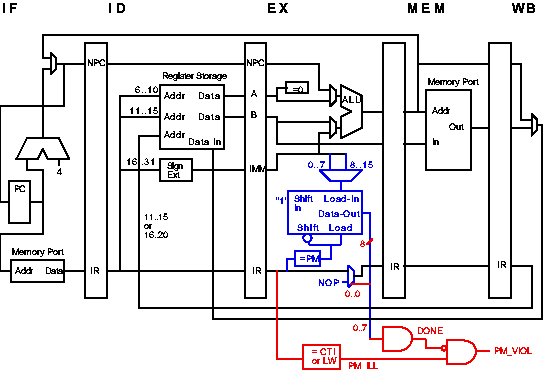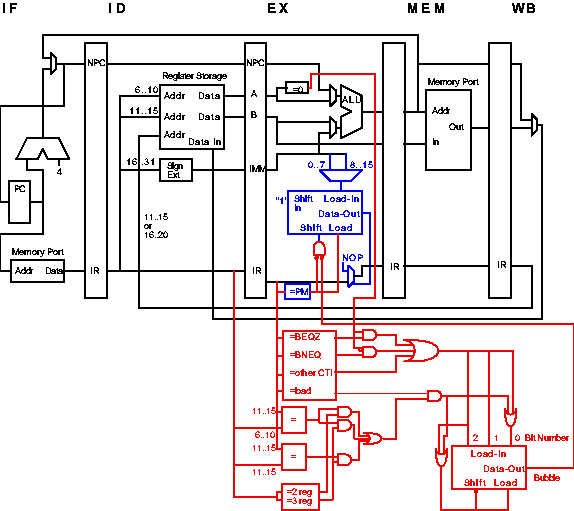
With R4 = 0:
Time:0 1 2 3 4 5 6 7 8 9 10 Mask: 0 1 0 1 1 1 1 1 PM IF ID EX MEM WB ADD IF ID XEX XMX XWX LW IF ID EX MEM WB SUB IF ID EX MEM WBBelow, the SUB instruction executes normally (albeit with a stall) because the NOP was inserted in the EX stage while SUB was stalled in ID.
With R4 = 1
Time:0 1 2 3 4 5 6 7 8 9 10 Mask: 1 0 1 1 1 1 1 1 PM IF ID EX MEM WB ADD IF ID EX MEM WB LW IF ID XEX XMX XWX SUB IF ID EX MEM WBNote that, if the controller doesn't know that LW will be nullified, it will have to stall SUB to avoid the possible RAW hazard. (The stall is unnecessary in this case.)
For R4 = 1, R5 = 0, Mask = 00010011
Time: 0 1 2 3 4 5 6 7 8 9 10 Mask: 1 1 0 0 1 0 0 0 PM IF ID EX MEM WB ADD IF ID EX MEM WB IF ID XEX XMX XWX BEQZ IF ID EX MEM WB IF ID XEX XMX XWX SUB IF ID IF ID XEX XMX XWXFor R4 = 1, R5 = 1, Mask = 00010011
Time: 0 1 2 3 4 5 6 7 8 9 10 Mask: 1 1 0 0 1 0 0 0 PM IF ID EX MEM WB ADD IF ID EX MEM WB BEQZ IF ID EX MEM WB SUB IF ID XEX XMX XWXFor R4 = 0, R5 = 1 or R5 = 0, Mask = 11111100
Time: 0 1 2 3 4 5 6 7 8 9 10 Mask: 0 0 1 1 1 1 1 1 PM IF ID EX MEM WB ADD IF ID XEX XMX XWX BEQZ IF ID XEX XMX XWX SUB IF ID EX MEM WB
These changes are shown below; blue indicates changes for homework 3 and red indicates changes for this problem. Note the exaggerated inversion bubble at the shift register shift input.

|
For loads and branches to be properly nullified, the shift register
must not be clocked when bubbles are passing though the EX stage. The
simplest solution is to assume that the controller can provide a
"bubble bit" in the EX stage; when such a bit is 1 the shift
register is not clocked. If a bubble bit is not already provided, it can be synthesized by checking for the two stall conditions: a load instruction with a RAW hazard, and a taken branch or any other CTI. A bubble shift register is set to the number of stall cycles, one bit for a load, and three for a taken branch. The register is either loaded, as described above, or shifted. If the bit out is one, then the PM shift register is not shifted. The load stall is detected by checking for a load instruction in the EX stage and any |
instruction reading registers in the ID stage.
If
the register written by the load is the same as either of the
registers read by
the instructions in ID, then one bit
in the bubble register is set. Instructions using one and two
source registers need to be distinguished. CTIs can be detected in the EX stage. If instruction in EX is a jump, jump/link, or a taken branch, three bits in the bubble shift register are set. These changes are shown below; blue indicates changed for homework 3 and red indicates changes for this problem. The solution below assumes that NOPs are inserted into the IR in place of the stalled instructions. What if that assumption is not correct? |




| David M. Koppelman - koppel@ee.lsu.edu | Modified 18 Mar 1997 18:39 (0:39 UTC) |